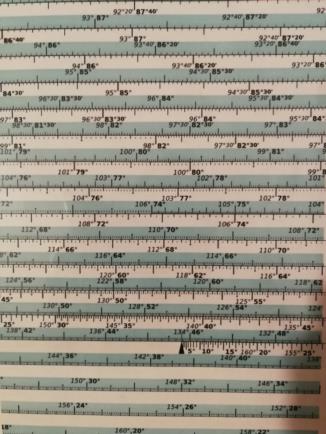
NavList:
A Community Devoted to the Preservation and Practice of Celestial Navigation and Other Methods of Traditional Wayfinding
From: Tibor Miseta
Date: 2021 Jul 30, 15:13 -0700
There may be others like me, who are interested in making a Bygrave (or MHR1) replica. There are excellent descriptions, samples, scales and instructions here on NavList. Before starting such a (at least for me) big project, I played a bit with flat Bygraves that I found on this list, checked out Gary LaPook's original modern flat Bygrave, Robin G. Stuart's "double index" version and of course the on-line version too, just to see how it works. I preferred the original over the "double index" because it can be always read without switching the indexes, and liked the online version because its non overlaping scales. The overlaping scales are hard to read for my eyes, and none of them is "full scaled".
I realized that by doubling the cosine scale instead of the cotangent in Gary's version, the pitch of the scales could be doubled on an A4 sheet without loosing the scales resolution. This modification let us making "slide rule like" non overlaping scales, and the more available space allows to extend the marks up to 180°. The cotangent scale doesn't fit on a sheet this way, but printing on both side, one can turn it over if runs out of the scale.
My first idea was modifying Robin G. Stuart's excellent scales this way, but soon realized, that Postscript would overthrow me, so I hacked a separate program to generate these scales.
I share the result, a "traditional" flat Bygrave with scales up to 180°, so the orignal instructions can be applied and tested. The azimuth rules in the original manual work nice for visible bodies (bodies over the horizon) only, they had to be extended for negative altitudes and great circle distance calculations. The instructions are printed along the cotangent scale.
Remember: you EITHER use the instructions in the original manual and the full scale length (up to 180°) OR use Gary's modern flat Bygrave solver sheet with the half scale (up to 90°). The two is not interchangeable!
I have made a few dozen test calculations, the accuracy is roughly 1-2 nm error in Hc. Turning over of the cotangent scale is not frequently needed, at least at mid latitudes, usually one side of the cotangent scale is enough. One calculation is roughly 3-5 minutes, but could be improved with practice, I guess. The Bygrave is good for its speed, not for extraordinary accuracy.
I appreciate any suggestions, recomendations to improve!
Some instruction to print, for those who would like to check it out:
Print the cosine scale on a transparency film.
Print the cotangent scales on normal paper: print pages 2-3 on both side with flip on SHORT edge, optionally print pages 3-4 on both side with flip on SHORT edge. That way it's easy to turn over the cotangent scale if necessary.
A good quality printer is highly recomended! The paper slips very slightly in my home printer (printing distorted and non-parallel scales) that I did not noticed until starting this project. The office printer made a good job.
To check the print accuracy: set the index (cos) at 44°49' (ctg), the two marks at 88°40' must match.
Best regards:
Tibor







